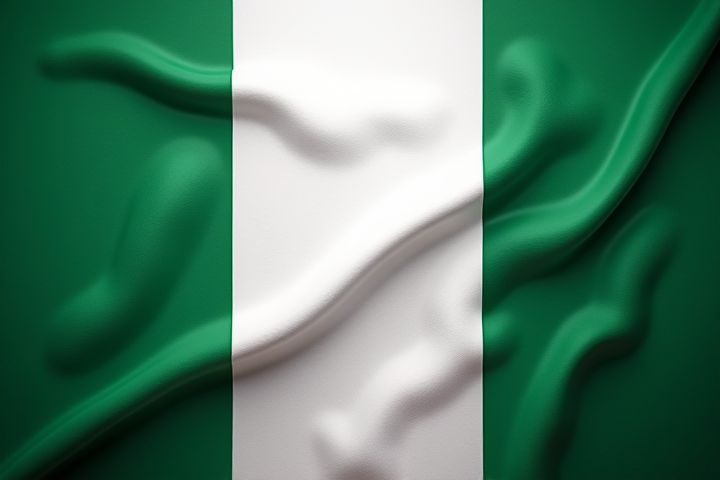
The Nigeria flag features three vertical stripes: two green outer stripes and a white vertical stripe in the center. The green symbolizes the country's lush vegetation and agricultural heritage, while the white represents peace and unity among its diverse cultures and ethnic groups. The flag's proportions are 1:2, making it visually balanced and harmonious. Adopted in 1970, it replaces the previous flag designed in 1959, reflecting Nigeria's commitment to democratic values. You can often see this flag displayed during national events, celebrations, and diplomatic representations.
Vertical tricolor
The Nigeria flag features a vertical tricolor design, consisting of three vertical stripes. The outer stripes are vibrant green, symbolizing the country's abundant natural resources and lush vegetation. The central stripe is white, representing peace and unity among Nigeria's diverse cultures and ethnic groups. This distinct arrangement not only embodies national pride but also reflects Nigeria's commitment to growth and harmony.
Green stripe on left
The Nigerian flag features three vertical stripes, with vibrant green bars on both the left and right sides, encompassing a white center stripe. The green color symbolizes the country's lush vegetation, agricultural abundance, and rich natural resources, reflecting Nigeria's economic focus on agriculture. The white stripe signifies peace and unity, offering a balance to the bold green hues. When you see the flag, the striking contrast between green and white embodies Nigeria's aspirations for both natural richness and harmonious coexistence among its diverse population.
White stripe in middle
The Nigeria flag features three vertical stripes, with the outer stripes being green and the center stripe white. The green represents the country's lush vegetation and natural resources, while the white signifies peace and unity among its diverse population. The simplicity of the flag's design symbolizes Nigerian values and aspirations, reflecting a commitment to harmony and national pride. This combination of colors serves as a powerful representation of Nigeria's cultural identity and environmental wealth.
Green stripe on right
The Nigerian flag features three vertical stripes with the two outer stripes in green and the central stripe in white. The green stripes symbolize the country's rich agricultural resources and vibrant vegetation, reflecting its role as a leading producer of crops like yams and cassava. Your focus on the right green stripe emphasizes the nation's commitment to environmental sustainability and the importance of its natural landscapes. This distinctive design not only embodies national pride but also represents the hope and unity of the Nigerian people.
Green represents agriculture
The Nigeria flag features three vertical stripes, with the outer stripes in vibrant green and the middle stripe in pure white. The green color represents the country's rich agricultural landscape, symbolizing Nigeria's vast potential in farming and natural resources. Agriculture plays a crucial role in Nigeria's economy, contributing significantly to employment and food security. This emblematic design reflects the nation's commitment to harnessing agricultural prosperity for national development.
White symbolizes peace
Nigeria's flag features three vertical stripes, with two vibrant green outer stripes and a central white stripe. The green represents the country's lush vegetation and agricultural wealth, while the white symbolizes peace and unity among its diverse ethnic groups. This thoughtful design reflects Nigeria's commitment to harmony and tranquility amidst its rich cultural tapestry. By displaying this flag, you embrace the values of peace and stability that resonate deeply within the nation.
Simple design
The Nigeria flag features a simple yet striking design characterized by three vertical stripes. The two outer stripes are green, symbolizing the country's lush vegetation and agricultural wealth, while the central stripe is white, representing peace and unity. This minimalist approach reflects Nigeria's commitment to environmental sustainability and harmony among its diverse cultures. Your understanding of this flag design can enhance your appreciation of Nigeria's national identity and values.
No emblem or symbol
The Nigeria flag consists of three vertical stripes, with the outer stripes colored green and the middle stripe colored white. The green represents the country's lush vegetation and agricultural heritage, while the white symbolizes peace and unity among its diverse population. This simple yet powerful design reflects Nigeria's commitment to both environmental and social harmony. Without any emblem or symbol, the flag's colors stand out as a representation of national identity.
Adopted design
The Nigeria flag features three vertical stripes: green, white, and green. The two green stripes symbolize the nation's abundant natural resources and its rich agricultural heritage. The central white stripe represents peace and unity among the diverse ethnic groups within the country. Adopted on October 1, 1960, the flag reflects Nigeria's aspirations for growth and harmony as it emerged from colonial rule.
Rectangular shape
The Nigeria flag features a rectangular shape with a unique design that consists of three vertical stripes. The two outer stripes are vibrant green, symbolizing the country's rich vegetation and natural resources, while the central white stripe represents peace and unity. The proportions of the flag are 2:3, making it ideal for display in various settings and ensuring visibility from a distance. You can easily identify this flag with its striking colors and meaningful symbolism, reflecting Nigeria's cultural identity.
